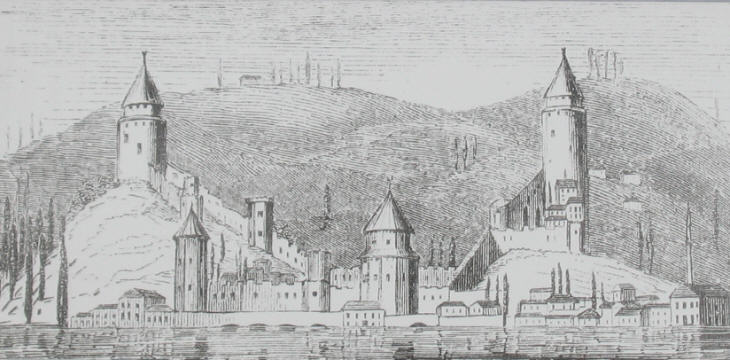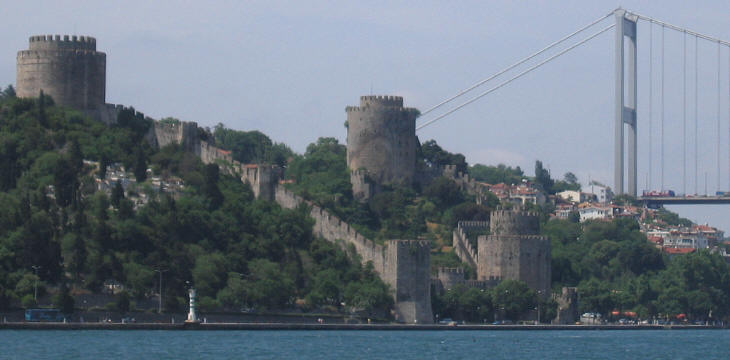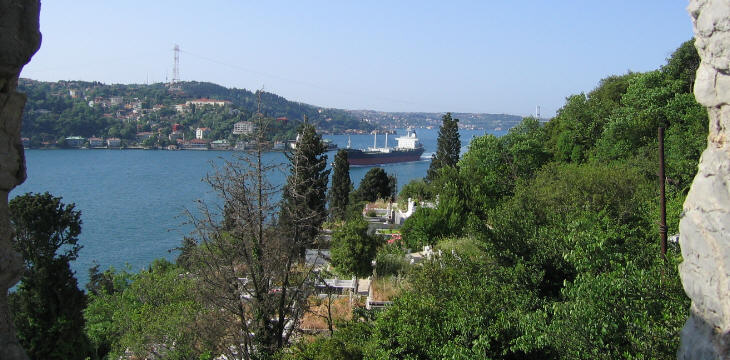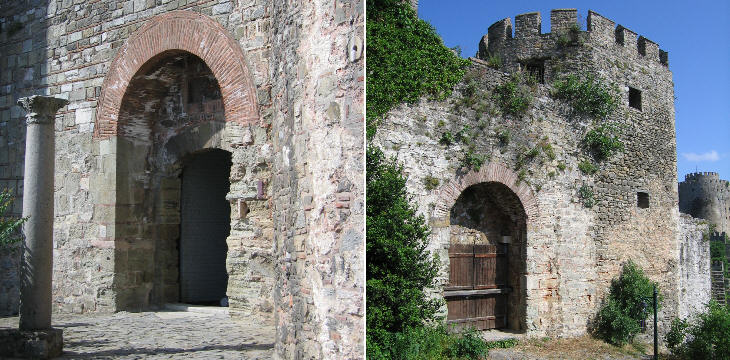  What's New! Detailed Sitemap All images © by Roberto Piperno, owner of the domain. Write to romapip@quipo.it. Text edited by Rosamie Moore. Page added in July 2006. |
 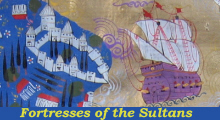 Rumeli Hisar Rumeli Hisar(detail of an Ottoman miniature showing Rumeli Kavagi, a lost fortress on the Bosporus) In 1451 the Ottoman possessions included most of the Balkans in Europe and western and central Anatolia in Asia. The sultans had set their residence in Adrianopolis (Edirne in today's European Turkey, next to the border with Greece and Bulgaria). The Byzantine Empire was limited to the city of Constantinople and to the despotate of MistrÓ in southern Greece. In that year Sultan Murat died of a stroke and was replaced by his son Mehmet II, a young man of 19. The new sultan was determined to conquer Constantinople overcoming the contrary advice of key members of the Ottoman court.
The Byzantine emperors did not constitute a threat for Mehmet II, but the conquest of Constantinople could lead to a sort of European crusade to defend or regain the city. Mehmet II did not fear so much a by land attack in the Balkans: in 1444 the Ottomans had already defeated at Varna (a port in Bulgaria) a similar attempt by the Hungarians: on that occasion they had been helped by a Genoese fleet to relocate their armies from Anatolia to Varna. Mehmet II was more worried about the Byzantines getting support from Venice and Genoa in response to appeals by the pope. He knew he had to act quickly and that he needed to ensure Genoa would not scuttle his plans: at that time Venice was at war with Milan and also other influential Italian states were involved in this conflict (including the extremely rich Republic of Florence); Mehmet realized it would take some time before the Italians put aside their rivalries (they actually did so when they signed the peace of Lodi in 1454, one year after the fall of Constantinople).
In a few months (in 1452) Mehmet II built a new fortress on the European side of the Bosporus opposite Anadolu Hisar. Rumeli Hisar (rock of Europe) was built on a hill controlling a turn of the Bosporus on the assumed location from which almost 2,000 years before the Persian Emperor Darius the Great had watched his army move into Europe.
Fatih (the Conqueror) is the title given to Mehmet II in recognition of his conquests and Fatih Bridge is the name given in 1987 to the second bridge which crossed the Bosporus. The bridge is right above the fortress built by Mehmet II and it is the site of spectacular traffic jams.
Constantine XI, the last Byzantine emperor, protested to Mehmet II claiming that the fortress violated the treaties between the two countries: in return Mehmet II charged Constantine with having interfered in dynastic quarrels in the Ottoman ruling family; Mehmet arranged the killing of his own young brother to make sure this would not occur again. In essence the building of Rumeli Hisar was tantamount to a declaration of war: because at that time they fought only during the season of better weather, the actual conflict broke out in the following year: the fateful 1453.
Rumeli Hisar is perhaps the first fortress built in Europe taking into account the use of cannon. From the top of its three octagonal/circular gigantic towers the Ottomans could fire at a great distance, while a battery of cannon right on the edge of the Bosporus could hit at close range any ship attempting to attack the fortress.
The three towers were placed inside a curtain of walls which here and there show the use of pieces of columns and of other material taken from ancient buildings.
The Genoese too resented Mehmet's decision to build Rumeli Hisar, as they regarded the Bosporus as a strait they controlled (they had acquired from the Byzantines two other fortresses located a few miles north of Rumeli Hisar), but they chose to acquiesce to the violation of treaties and when Mehmet II laid siege to Constantinople they eventually proclaimed the neutrality of their colony in Galata. Fortresses of the Sultans - Introduction Fortresses built before 1453: 1 - Anadolu Hisar 2 - Rumeli Hisar Fortresses built after 1453 and before 1657: 3 - Kale Sultanieh 4 - Kilitbahir Fortresses built after 1657: 5 - Seddulbahir 6 - Imbro 7 - Tenedo Clickable Map of Turkey showing all the locations covered in this website (opens in another window) |
